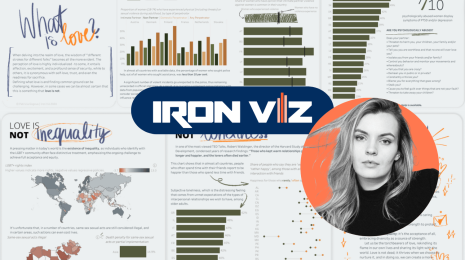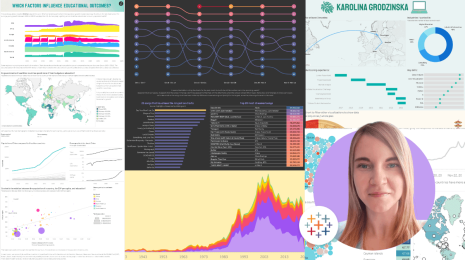Roundup of Tableau Public's Data in the Wild Sources
February is #DataInTheWild month at Tableau Public. In today's digital world, data really is all around us. These days when you walk down the street to buy milk from the grocery store, you generate data with your fitbit. When you fall asleep after a long day at work, you generate data through the Sleep Cycle app on your iPhone. When you listen to music you generate data through Spotify. But with all this data out there - "In the Wild" - where should people go to access it? This is a question the Tableau Public team fields all the time, so we thought it would be useful to our community of authors if each of us shared one of our favorite places to go find data on the internet.
What follows is Tableau Public's roundup of our favorite places to find Data in the Wild.
Andrew is a fan of researching scientific data, especially when it pertains to his favorite foodgroup
"Scientists generate enormous amounts of research data. Luckily, other scientists often sift through and compile research data into a single database. In the United States, if the research was funded by public grants, these databases will be made available to download by the public.
Before I worked for Tableau, I was interested in visualising the mercury content of popular seafood species. Searching for "mercury seafood database" brought me to Stony Brook University's seafood mercury database, a dataset that contains average mercury concentrations for approximately 1633 seafood samples.
With some additional manual data entry of trophic levels, my very first dashboard was born:
Jewel likes to go to her favorite website - Reddit - to find Data in the Wild
“I know that I already talk about it way too much, but I really freaking love Reddit. There’s all kinds of cool insights you can make about the communities of Reddit by scraping posts and analyzing karma and word frequencies in titles. There’s also subreddits where people are making their own data like /r/samplesize Not to mention, there’s a whole community dedicated to sharing data and helping people find what they are looking for, aptly named /r/datasets. ”
Dash chose a repository of sports statistics, Pro-Football-Reference.com
"I love sports. Oftentimes, when I'm sitting around thinking of what I would like to analyze in my next Tableau Public viz, I reflexively think of sports questions that I want to answer. There are just so many of them out there that require data exploration! This was my line of thinking in the fall, when I was transfixed by the college football and NFL seasons that had just gotten underway. I wanted to visualize which colleges produced the best NFL players - specifically the best fantasy football players. To do this, I needed fantasy football data, and a lot of it. Luckily for me, Pro Football Reference exists and I used a combination of an Import IO crawler and Pro Football Reference's yearly statistical leaders database to create the Tableau Public viz "Best Fantasy Football Factories".”
Tara's favorite is La Nación's presidential twitter analysis by Yanina Ronconi
"In today’s society, Twitter can be a powerful tool that can help candidates win elections. I enjoy that La Nación looked into various president’s social profile on Twitter to see which had the most followers and tweets. I also like that La Nación added presidents’ faces to the viz – it makes the viz feel more personal.”
Ellie enjoys MapLight's illustration of campaign contributions to the California Assembly and State Senators
"An older viz by MapLight is my favourite. It’s not as beautiful as the others, but for sheer impact, tracking the money that each state legislator gets and from who is pure gold.”
Dash decides to highlight Gazeta do Povo's visualization of the 2014 Brazilian presidential election
"I really like this viz because of how well designed it is. The severely washed-out map blends seamlessly with the white background, allowing the bright blue/red data points to jump out at the viewer. The solid design extends to the thumbnail image of the two cartoon-character candidates in the vim’s bottom right that is hilarious. Overall it is a very well executed political visualization that does playfully and artfully draws the attention of any/all viewers.”
Andrew appreciates El Comercio's illustration of changes in the Peruvian Congress by Ángel Hugo Pilares
"Though not as flashy as others, Pilares did a great job of illustrating how the distribution of party seats changed between 2011-2014. His clean, intuitive design invites readers to discover which parties have dominated in the past few years and which ones were able to gain only a temporary foothold in Peru's legislative body."
Hopefully highlighting these great political visualizations has geared up your imagination. And we'd like to give a huge thanks to all the authors featured here for contributing such stellar examples to our community!
Download Tableau Public 8.2 to try it for yourself!
Related Stories
Subscribe to our blog
Get the latest Tableau updates in your inbox.















